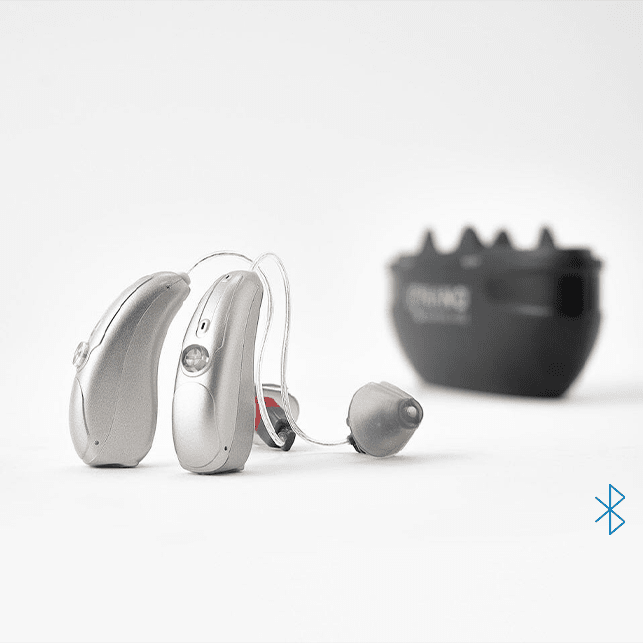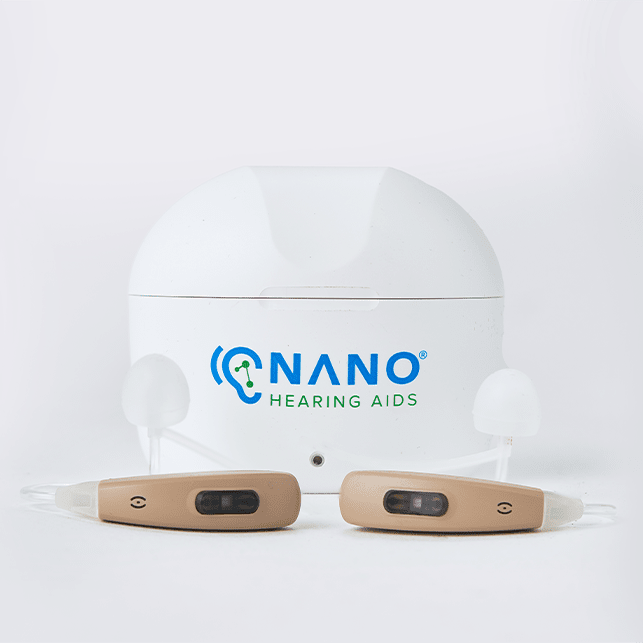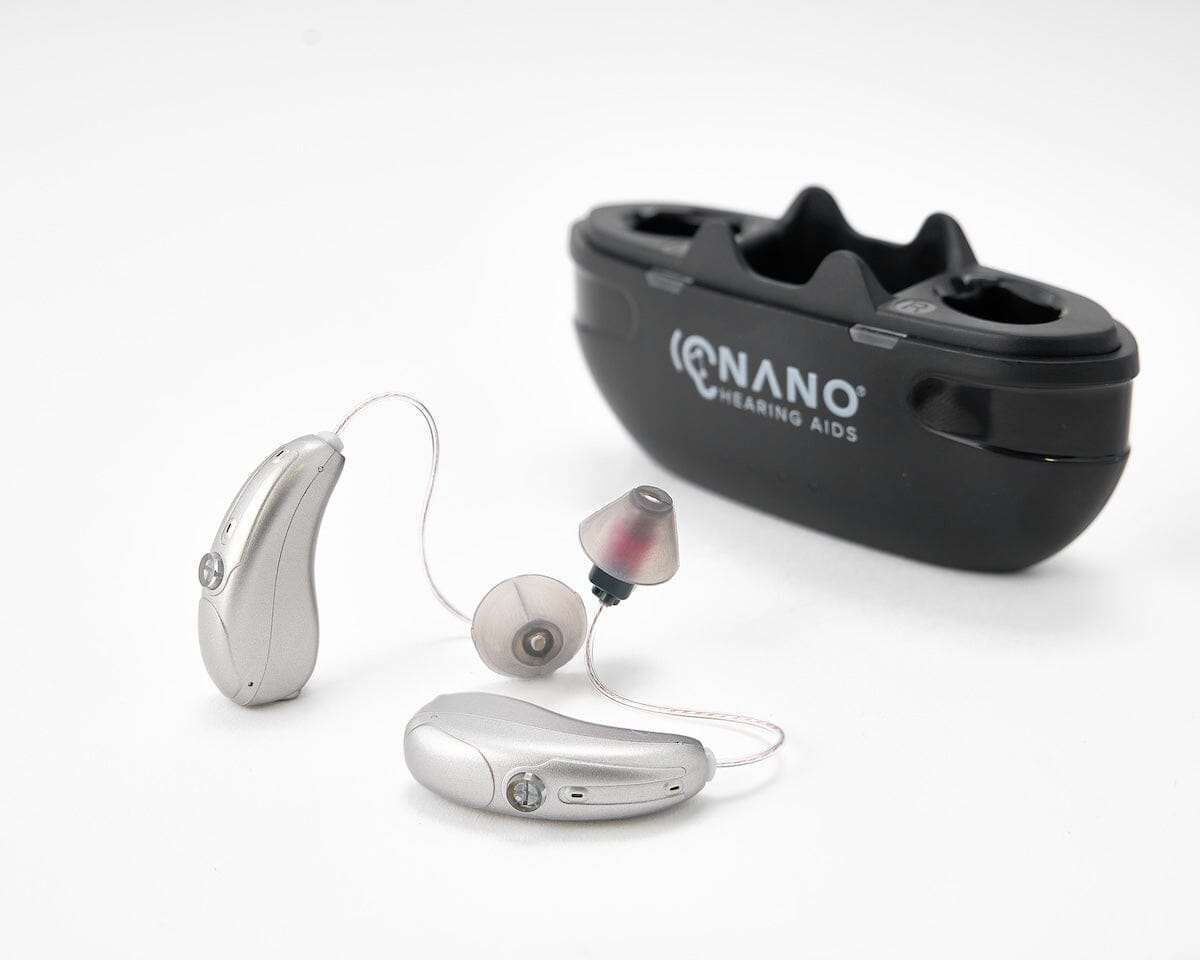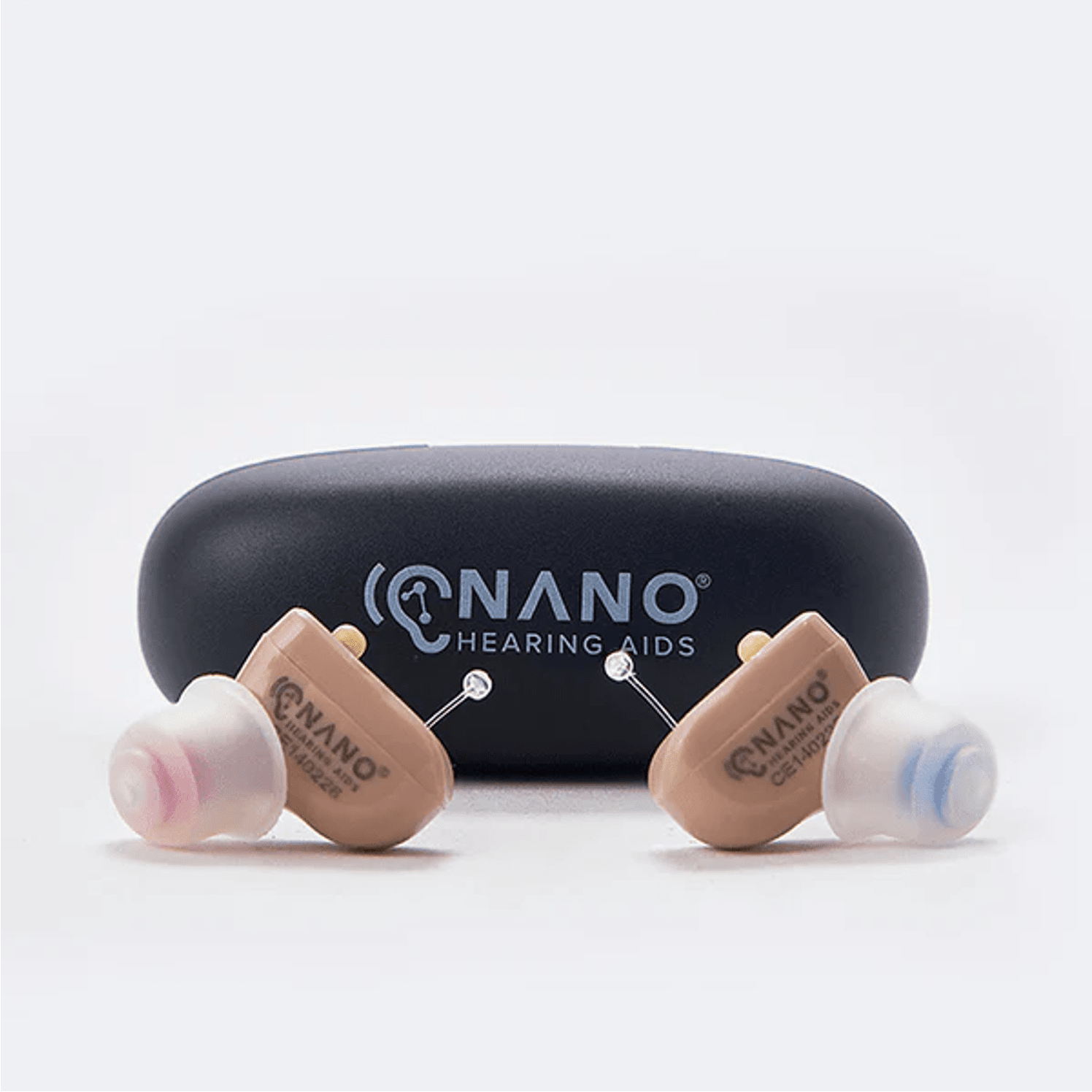Key Takeaways
- Hearing aids are FDA-regulated medical devices specifically designed for people with perceived mild to moderate hearing loss, while PSAPs are not regulated and are meant to amplify environmental sounds for non-hearing impaired users.
- Over-the-counter (OTC) hearing aids provide a customizable solution without the need for a prescription.
- Hearing aids provide advanced features such as noise reduction, directional microphones, and connectivity options, whereas PSAPs generally offer basic sound amplification.
- PSAPs are usually less expensive than hearing aids but do not offer the same level of customization or hearing health support.
- Nano’s First Ear Pro CIC and Audacity RIC OTC hearing aids are FDA-registered Class I medical devices, offering advanced features like noise reduction, Bluetooth connectivity, feedback cancellation, noise management, and rechargeable batteries.
NANO Hearing Aids are FDA-registered, Class I devices. Our OTC hearing aids are designed for individuals over 18 years of age with perceived mild to moderate hearing impairment. With prices starting at just $297, they offer a viable solution for those looking to improve their hearing without breaking the bank.
What are Hearing Aid and Personal Sound Amplification Products (PSAPs)
Understanding Hearing Aids and PSAPs
Hearing aids are medical devices regulated by the FDA - they are designed to help individuals with hearing loss by amplifying certain sounds to compensate for their specific type of hearing impairment.
These devices often come with advanced features like noise reduction and directional microphones, making them highly effective for those with hearing difficulties.
PSAPs, on the other hand, are not regulated as medical devices.
They are designed to amplify all environmental sounds for individuals without hearing loss, often used for activities like bird watching or eavesdropping on distant conversations. They lack the sophisticated technology found in hearing aids - making them less suitable for treating hearing loss.
Who Can Benefit from Each Device
Hearing aids are ideal for individuals diagnosed with hearing loss - custom-programmed by a hearing care professional to meet specific needs. This customization ensures the hearing aid amplifies the right sounds and reduces background noise, providing a clearer hearing experience.
PSAPs are best for people with normal hearing who need to amplify environmental sounds. A PSAP can help hear a lecture better in a large hall or listen to birds while hiking. Since PSAPs do not cater to individual hearing needs, they are not recommended for those with hearing loss.
Nano First Ear Pro CIC
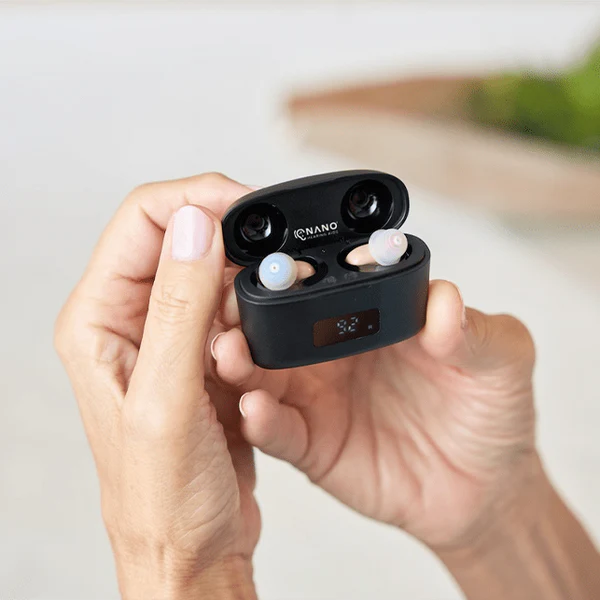
Regulatory Status and Classification
Hearing aids are classified as medical devices by the FDA - they must meet strict safety and efficacy standards before they can be marketed. This classification ensures that hearing aids are safe and effective for treating hearing loss.
PSAPs, in contrast, are not regulated by the FDA. They are considered consumer electronics rather than medical devices.
This lack of regulation means PSAPs do not undergo the same rigorous testing as hearing aids, and they may not provide the same level of safety or effectiveness for individuals with hearing loss.
Features of Hearing Aids and PSAPs
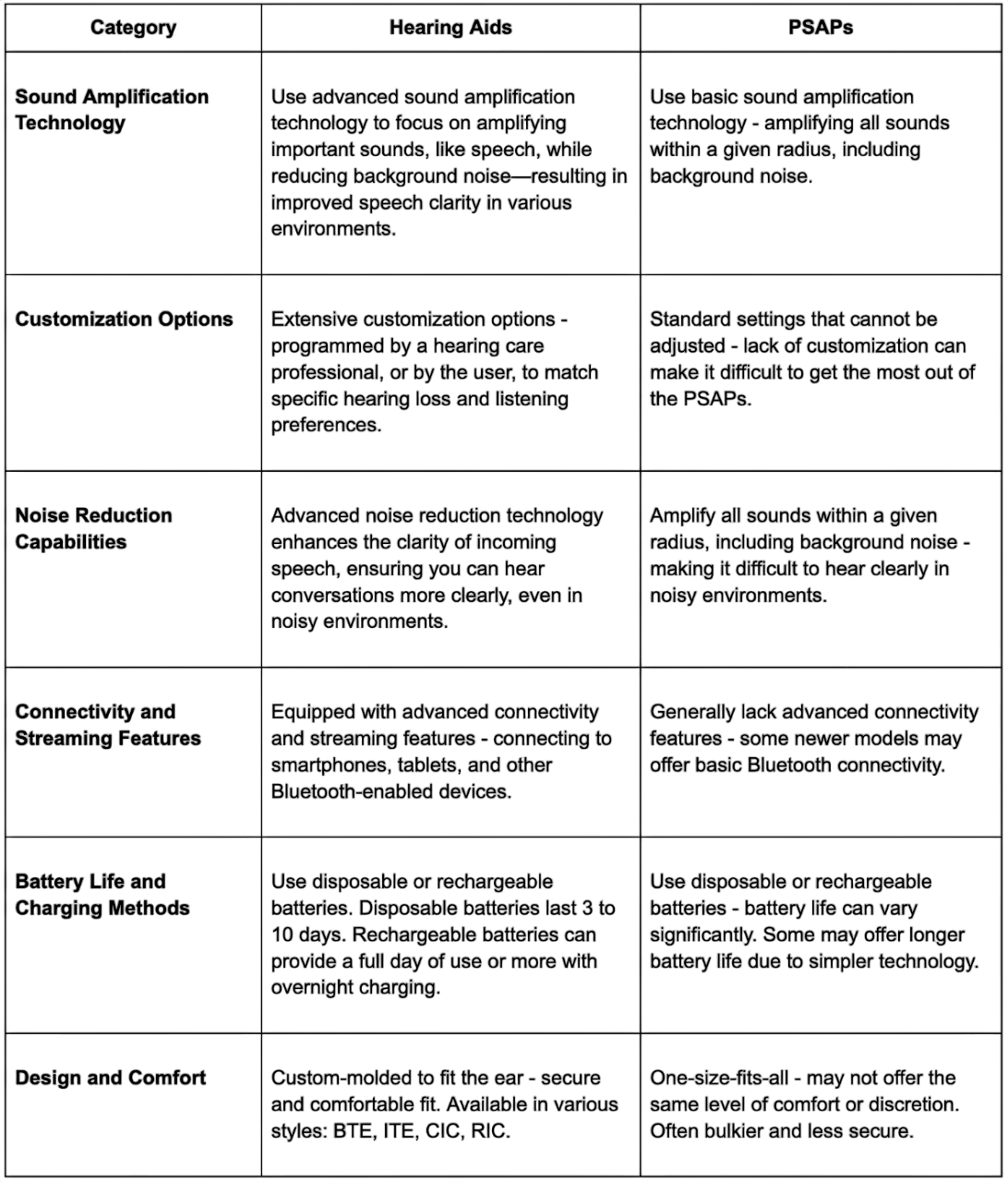
Pros & Cons of Hearing Aids and PSAPs
Hearing Aids
Pros:
- Advanced sound amplification technology that selectively amplifies needed sounds while reducing background noise.
- Customizable settings, designed specifically for the user's hearing loss and preferences.
- Noise reduction capabilities that enhance speech clarity in noisy environments.
- Connectivity and streaming features that integrate with smartphones and other devices.
- Custom-molded designs provide a secure and comfortable fit.
Cons:
- Higher cost compared to PSAPs, making them less accessible for some.
- Not all hearing aids require professional fitting and customization—OTC hearing aids, like Nano, do not—but some may involve multiple visits to a hearing care professional.
- Device maintenance and potential repairs can add to the overall cost and inconvenience.
PSAPs
Pros:
- Lower cost compared to hearing aids, making them more accessible for individuals on a budget.
- Available without a prescription or professional fitting, allowing easy purchase and use.
- Simple design and basic amplification features, useful for activities like bird watching or attending lectures.
Cons:
- Lack of customization options, making them less effective for individuals with hearing loss.
- Basic sound amplification that amplifies all sounds, including background noise, which can affect clarity in noisy environments.
- One-size-fits-all design may not provide a secure or comfortable fit.
How Nano Hearing Aids Can Help
The Nano First Ear Pro CIC model features a nearly invisible fit and a compact charging case, making it a convenient option for daily use.
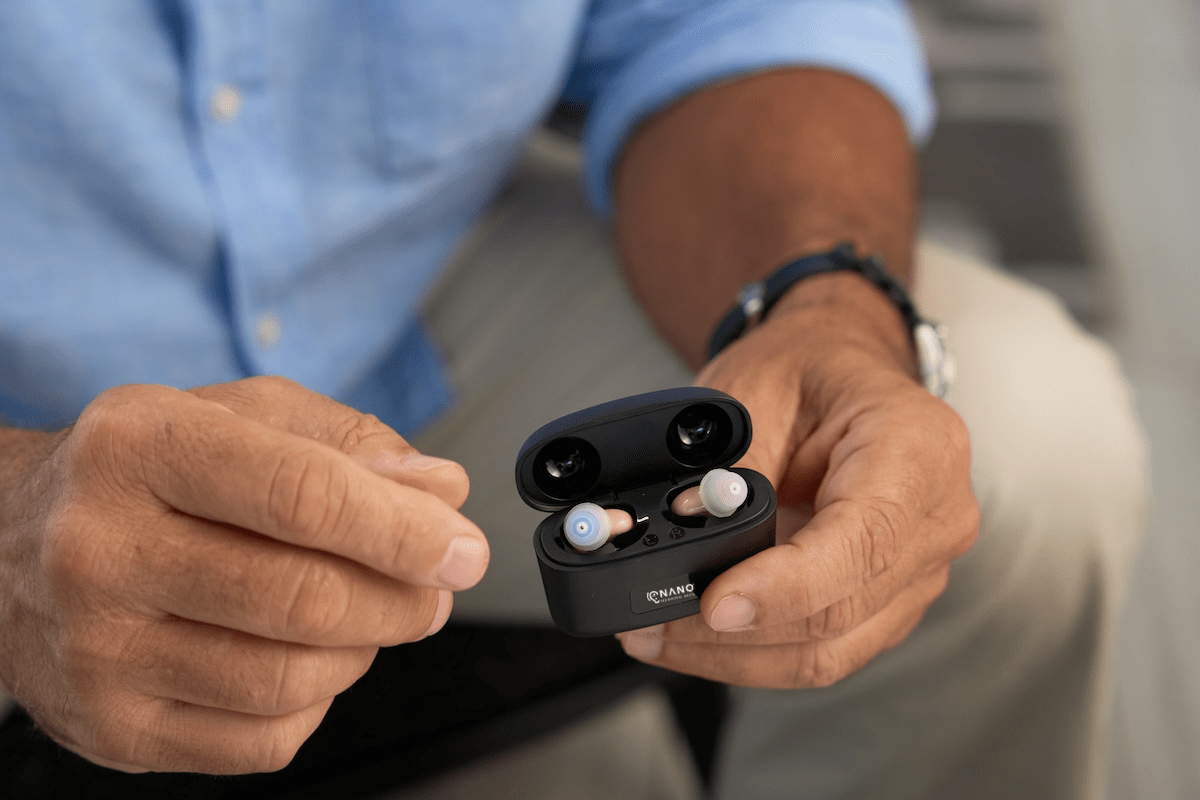
At Nano Hearing Aids, with over 7 years of expertise, our FDA-registered Class I medical devices stand out in the hearing aid vs. PSAPs comparison.
Unlike PSAPs, which are not regulated and primarily amplify ambient sounds, Nano hearing aids are designed for precise hearing needs.
Our devices feature advanced capabilities like noise reduction and directional microphones - ensuring a superior hearing experience. Available over-the-counter, they offer an affordable and effective solution for perceived mild to moderate hearing loss, making them a more reliable and tailored choice compared to PSAPs.
Our models include the First Ear Pro CIC, priced at $397, featuring three listening programs, simple push-button control, powerful feedback cancellation, and rechargeable batteries with up to 26 hours per charge. Its nearly invisible design ensures discreet use.
The Audacity RIC, priced at $697, offers full control with the Nano Audacity App, Bluetooth connectivity, a portable charging case, three listening programs, and powerful noise management. Choosing Nano hearing aids means opting for a technologically advanced, easy-to-use, and affordable solution that enhances your hearing and improves your quality of life - without the limitations and lack of customization associated with PSAPs.
Frequently Asked Questions (FAQ)
What is the main difference between a hearing aid and a PSAP?
The main difference between a hearing aid and a PSAP is their intended use and regulatory status.
Hearing aids are FDA-regulated medical devices designed to treat hearing loss - while PSAPs are consumer electronics intended to amplify environmental sounds for individuals without hearing impairment.
Do I need a prescription to buy a hearing aid or PSAP?
You do not need a prescription to buy a PSAP - they are available over the counter.
Traditional hearing aids typically require a prescription and fitting by a hearing care professional. Over-the-counter (OTC) hearing aids provide a middle ground, offering customizable solutions without a prescription.
Can PSAPs be used to treat hearing loss?
No, PSAPs are not intended to treat hearing loss - they are designed to amplify environmental sounds for individuals without hearing impairment.
Using a PSAP to treat hearing loss can be ineffective and may even cause further damage to your hearing.
How do I know which device is right for me?
If you have been diagnosed with hearing loss - a hearing aid is likely the better choice. If you have normal hearing but need to amplify environmental sounds - a PSAP may be suitable. Consult with a hearing care professional to determine the best option for you.
Why Should I Choose Nano Hearing Aids?
Nano Hearing Aids offer a regulated, high-quality solution for those with perceived mild to moderate hearing loss.
Unlike PSAPs, which are not FDA-regulated and offer basic amplification, Nano Hearing Aids are FDA-registered, Class I medical devices - ensuring safety and effectiveness.
Our models, such as the First Ear Pro CIC and Audacity RIC, feature advanced technologies like noise reduction and Bluetooth connectivity, providing a superior hearing experience compared to the simpler functionality of PSAPs.

